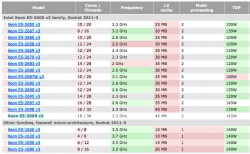I would add two additional questions to this we're trying to answer here...
#3
Should I buy a nMP now or wait for Haswell?
If you need a new workstation with 4-8 cores, there's no point in waiting... buy a 6,1 now.
this has little to nothing to do with core count. If actually need a Mac Pro ( missing out on business demands because don't have one) then should buy one.
Is an update immediately eminent because the Core i7 59xxk models have dropped? No. Apple isn't going to use Core i7's and the Xeon E5 v3 isn't necessarily immediately coming at the same time ( For Xeon E5 v1 they were displaced almost a whole quarter from the Core i7 release. )
if the current Mac Pro was not "fast enough" to warrant a purchase then it still isn't.
#4
Will Apple update the MP6,1 with Haswell-EP?
Of course they "should" update the MP6,1 with Haswell as many have discussed, however, there is no guarantee that they will. I think it's unwise to assume the update cycle revolves strictly around Intel on this product given the importance of the GPUs.
Problem is that the GPUs have updated also. The new AMD GCN 1.1 products are OpenCL 2.0 capable and the current GPU cards are not. Several of the new ones may have DSPs ( depends up if dressing up mainstream or really getting FirePro variants ) that Apple might leverage so audio customers don't have underwear in a twist over two GPU cards.
The PCH has moved. the CPU has moved, the GPUs have moved, the memory tech has moved. Almost everything have moved on. Apple could snore on all that. But it is gross mischaracterization that only the x86 cores have progressed here. The Mac Pro 2013 was late..... waaaaaaaaaaaay late.
About the only the tech there that was bleeding edge was the TB v2 and then only because it is was in the ramp to volume production phase of manufacturing.
Waiting for E5 v4 is something Apple could do, but it is a pretty bonehead move.
Apple effectively has three options:
1. Update the nMP when Haswell-EP becomes available regardless of available GPUs - Many people have stated why they should do this even though there are only incremental gains to be had
Yet another bonehead option. If the GPUs were coming 8-9 months in the future then perhaps. But the new GPUs are
already announced or released . The FirePro 8100/9100 are out:
http://www.amd.com/en-us/products/graphics/workstation
The 7100 is already announced and should ship relatively soon:
http://www.anandtech.com/show/8371/amd-firepro-w7100-w5100-w4100-w2100
News about Intel Xeon E5 v3 is leaking like a sieve right not but Intel actually hasn't officially announced them yet. In contrast, the new GPUs have already been announced. ( even if Apple switched over to Nvidia they announced the same time AMD did. )
It is likely only the delayed OS X drivers that are the only hold up. The hardware exists. It would be extremely ass-backwards to skip a system when hardware is available. Apple doesn't need to release anything right now anyway so even if need until January to finish up the drivers it isn't a problem.
[ Turning an update on the Mac Pro out in less than 12 months is baseless in need (they have only had a couple months of steady state supply-demand ) and actually would be setting unrealistic expectations for the future. ]
if the GPUs and CPUs drift largely out of synch then doing one without the other makes sense on the Mac Pro. But when upgrades launch inside of 3-4 months of each other, it doesn't much any sense to separate them. Especially on a product that would be about an approximately 12 month upgrade cycle. Going from 12 to 15 isn't the end of the world. Frankly with the rapid firmware fixes that followed the last Mac Pro release the bake time isn't excessively long here either anyway.
2. Update the nMP with Haswell-EP but only when next-gen GPUs become available from AMD - which would mean a delayed refresh but one that carries more impact
The basic hardware is out. What waiting on is only Apple's custom board hardware tweaks and drivers (the latter at low level is still AMD ).
3. Skip Haswell-EP and wait for Broadwell-EP - I'm not sure this makes sense but they have clearly done this with the Mac Mini so it's possible, although perhaps not very likely.
There is no 100% proof right now that Apple has skipped Haswell for the Mini. The Mini hasn't shipped but unless shifting to Core M CPUs there is marginal benefits that Broadwell is going to buy the Mini over a straightforward update of the Mini with Haswell.
Xeon E5 v4 (Broadwell-EP) isn't bringing magic pixie dust any more than delaying until Xeon E5 v2 brought magic pixie dust for the Mac Pro 2013. The delta from v3 to v4 isn't going to be huge. It will probably be almost the same delta this thread started off "complaining" about not being worthy of an upgrade. Apple stalling until late 2013 to synch up with Thunderbolt v2 didn't "buy" a whole lot one the x86 performance front over most of the line up. They got core count parity at the top end 12 cores ( same max core count as 2012 Mac Pro ) but not a huge leap over what Xeon E5 v1 would have done paired with TB v1.


